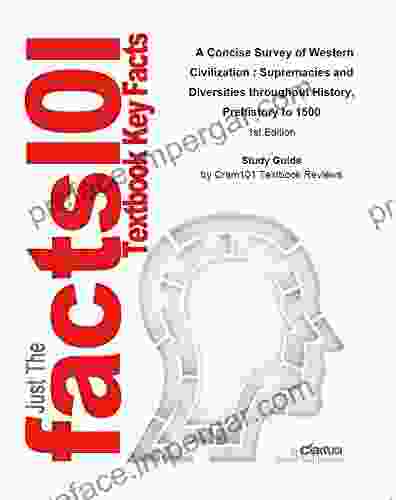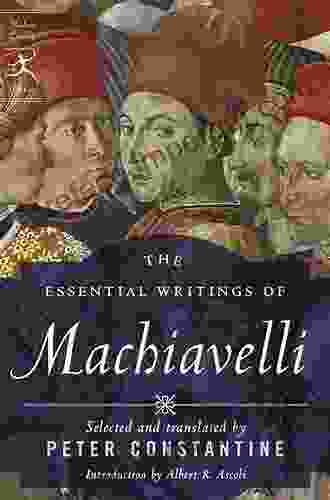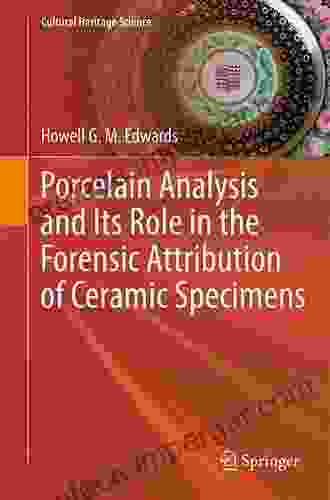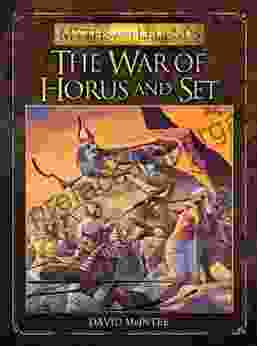Porcelain Analysis and Its Role in the Forensic Attribution of Ceramic

Porcelain, a captivating material renowned for its exquisite beauty and enduring strength, has captivated civilizations for centuries. Its allure extends beyond aesthetics, as porcelain holds a wealth of information, particularly in the realm of forensic investigations. Porcelain analysis has emerged as an invaluable tool in attributing ceramic artifacts to their rightful origins, providing crucial insights into their history, provenance, and potential involvement in illicit activities.
4.5 out of 5
| Language | : | English |
| File size | : | 22546 KB |
| Text-to-Speech | : | Enabled |
| Enhanced typesetting | : | Enabled |
| Word Wise | : | Enabled |
| Print length | : | 1006 pages |
| Screen Reader | : | Supported |
| Hardcover | : | 395 pages |
| Item Weight | : | 1.84 pounds |
| Dimensions | : | 6.14 x 0.88 x 9.21 inches |
| X-Ray for textbooks | : | Enabled |
Unveiling the Secrets of Porcelain Composition
At the heart of porcelain analysis lies a thorough understanding of its composition. Porcelain is primarily composed of three main ingredients: kaolin, feldspar, and quartz. Kaolin, a type of clay mineral, imparts whiteness and plasticity to the porcelain body, while feldspar acts as a flux, lowering the melting point of the mixture and facilitating vitrification. Quartz, the third component, contributes to the hardness and durability of the porcelain. The relative proportions and specific types of these ingredients vary depending on the origin and manufacturing techniques employed.
By analyzing the elemental composition of a porcelain artifact, forensic scientists can gain valuable insights into its provenance. Trace elements, present in minute quantities, can provide clues about the geological source of the raw materials used in its production. For instance, the presence of certain rare earth elements can indicate that the porcelain originated from a specific region or geological formation. Additionally, the isotopic ratios of elements, such as oxygen and strontium, can further refine the geographical attribution of the artifact.
Advanced Techniques for Porcelain Characterization
The advent of sophisticated analytical techniques has revolutionized the field of porcelain analysis, enabling forensic scientists to extract a wealth of information from these artifacts. These techniques include:
- X-ray Fluorescence (XRF) Spectroscopy: XRF analysis provides a rapid and non-destructive method for determining the elemental composition of porcelain. By bombarding the sample with X-rays, scientists can measure the characteristic X-rays emitted by different elements, providing quantitative data on their concentrations.
- Inductively Coupled Plasma Mass Spectrometry (ICP-MS): ICP-MS is a highly sensitive technique used to measure the isotopic ratios of elements. By introducing the sample into an inductively coupled plasma, scientists can separate and analyze the ions of different elements, revealing their isotopic compositions.
- Petrographic Analysis: Petrographic analysis involves examining thin sections of porcelain under a microscope to characterize its mineralogical composition and microstructure. This technique can provide insights into the firing temperature, cooling rate, and manufacturing techniques used in the production of the artifact.
- Scanning Electron Microscopy (SEM): SEM allows scientists to visualize the surface of porcelain artifacts at high magnifications. This technique can reveal microscopic features, such as grain size, porosity, and surface modifications, which can provide clues about the manufacturing process and potential alterations or repairs.
Forensic Applications of Porcelain Analysis
The insights gleaned from porcelain analysis have far-reaching applications in the forensic field, including:
- Authentication of Ceramic Artifacts: Porcelain analysis plays a crucial role in authenticating ceramic artifacts, particularly in cases of suspected forgery or misattribution. By comparing the elemental and isotopic composition of a questioned artifact to known reference samples, forensic scientists can determine whether the artifact is genuine or a replica.
- Provenance Determination: Porcelain analysis can assist in establishing the provenance of ceramic artifacts, identifying their geographical origin and cultural context. By analyzing the composition and comparing it to geological databases, forensic scientists can trace the artifact back to its source, shedding light on trade routes and cultural interactions.
- Identification of Illicit Trafficking: Porcelain analysis can aid in the identification of illicit trafficking of ceramic artifacts. By comparing the composition of seized artifacts to known reference samples, forensic scientists can determine whether they were illegally exported or imported, facilitating the repatriation of stolen cultural heritage.
- Archaeological Investigations: In archaeological contexts, porcelain analysis can provide valuable insights into past societies and their technological advancements. By studying the composition and characteristics of porcelain artifacts found at archaeological sites, researchers can gain knowledge about trade networks, cultural exchanges, and the evolution of ceramic production techniques.
Porcelain analysis has emerged as an indispensable tool in the forensic attribution of ceramic artifacts. By harnessing advanced analytical techniques, forensic scientists can unravel the secrets hidden within porcelain, uncovering its origins, history, and potential involvement in illicit activities. This knowledge empowers law enforcement agencies, cultural heritage institutions, and researchers alike to safeguard the integrity of our shared cultural heritage and to advance our understanding of past civilizations.
As technology continues to advance, the field of porcelain analysis is poised to reveal even deeper insights into the enigmatic world of ceramics. Its applications will undoubtedly continue to expand, shedding light on the complexities of human history and the enduring legacy of porcelain as a captivating and enduring material.
4.5 out of 5
| Language | : | English |
| File size | : | 22546 KB |
| Text-to-Speech | : | Enabled |
| Enhanced typesetting | : | Enabled |
| Word Wise | : | Enabled |
| Print length | : | 1006 pages |
| Screen Reader | : | Supported |
| Hardcover | : | 395 pages |
| Item Weight | : | 1.84 pounds |
| Dimensions | : | 6.14 x 0.88 x 9.21 inches |
| X-Ray for textbooks | : | Enabled |
Do you want to contribute by writing guest posts on this blog?
Please contact us and send us a resume of previous articles that you have written.
 Book
Book Novel
Novel Page
Page Chapter
Chapter Text
Text Story
Story Genre
Genre Reader
Reader Library
Library Paperback
Paperback E-book
E-book Magazine
Magazine Newspaper
Newspaper Paragraph
Paragraph Sentence
Sentence Bookmark
Bookmark Shelf
Shelf Glossary
Glossary Bibliography
Bibliography Foreword
Foreword Preface
Preface Synopsis
Synopsis Annotation
Annotation Footnote
Footnote Manuscript
Manuscript Scroll
Scroll Codex
Codex Tome
Tome Bestseller
Bestseller Classics
Classics Library card
Library card Narrative
Narrative Biography
Biography Autobiography
Autobiography Memoir
Memoir Reference
Reference Encyclopedia
Encyclopedia Prisha Singh
Prisha Singh Floyd Abrams
Floyd Abrams Donald K Yeomans
Donald K Yeomans Dr Richard Oppenlander
Dr Richard Oppenlander Samuel T Gladding
Samuel T Gladding Eze Ugbor
Eze Ugbor Peter Parker
Peter Parker Dmitriy Gutkovich
Dmitriy Gutkovich Helge Kragh
Helge Kragh Dr Margaret Matson Norris
Dr Margaret Matson Norris Hy Ruchlis
Hy Ruchlis Monte Burch
Monte Burch Jennifer Butler Green
Jennifer Butler Green Douglas Edward Leach
Douglas Edward Leach John P Blair
John P Blair Donna M Mcaleer
Donna M Mcaleer John Gribble
John Gribble Eddie James
Eddie James Dr Kourosh Maddahi
Dr Kourosh Maddahi Rachel Fehily
Rachel Fehily
Light bulbAdvertise smarter! Our strategic ad space ensures maximum exposure. Reserve your spot today!

 Blake KennedyMaster His Favorite Manipulation Technique To Be Always One Step Ahead And Be...
Blake KennedyMaster His Favorite Manipulation Technique To Be Always One Step Ahead And Be... William GoldingFollow ·17.8k
William GoldingFollow ·17.8k Cooper BellFollow ·12.3k
Cooper BellFollow ·12.3k Arthur MasonFollow ·5.8k
Arthur MasonFollow ·5.8k Hudson HayesFollow ·15.9k
Hudson HayesFollow ·15.9k Dwayne MitchellFollow ·9k
Dwayne MitchellFollow ·9k Fredrick CoxFollow ·11.7k
Fredrick CoxFollow ·11.7k John MiltonFollow ·15.2k
John MiltonFollow ·15.2k Jedidiah HayesFollow ·6.9k
Jedidiah HayesFollow ·6.9k

 Donovan Carter
Donovan CarterUnveiling the Tapestry of Western Civilization:...
: Step into the annals of Western...

 Pablo Neruda
Pablo NerudaUnveil the Secrets: The Welsh Murder Mysteries
Prepare to be captivated as...

 Benji Powell
Benji PowellNot Without Our Consent: Lakota Resistance to...
In the mid-20th...

 Ryan Foster
Ryan FosterUncover the Heroic Exploits of U.S. Navy Special Warfare...
The annals of modern warfare are replete...

 Gage Hayes
Gage HayesPlan to Provide Quality Care for All While Saving...
The healthcare...

 Felix Carter
Felix CarterUnveiling the Timeless Wisdom of Machiavelli: The...
Niccolò...
4.5 out of 5
| Language | : | English |
| File size | : | 22546 KB |
| Text-to-Speech | : | Enabled |
| Enhanced typesetting | : | Enabled |
| Word Wise | : | Enabled |
| Print length | : | 1006 pages |
| Screen Reader | : | Supported |
| Hardcover | : | 395 pages |
| Item Weight | : | 1.84 pounds |
| Dimensions | : | 6.14 x 0.88 x 9.21 inches |
| X-Ray for textbooks | : | Enabled |










